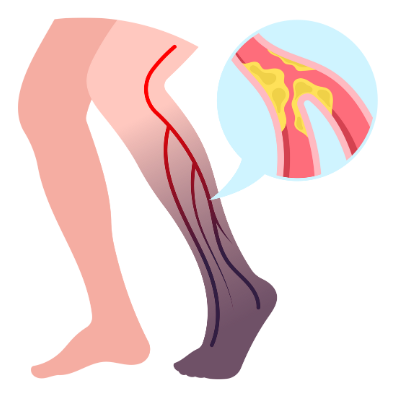Blog | Specialized Care
Peripheral Artery Disease: Early Detection Can Save Limbs and Lives
published: 5/7/2025
viewedby 3248 visitors
Introduction
Peripheral Artery Disease (PAD) occurs when the arteries that supply blood to the legs become narrowed or blocked by plaque. This leads to reduced blood flow, especially during physical activity, causing pain in the thighs or calves. PAD affects over 200 million adults worldwide and is common in both older men and women. It can also affect younger people,
particularly those with a history of smoking. Unfortunately, many people with PAD don’t realize they have it because its symptoms can be subtle or mistaken for other issues.

1. What Causes PAD?
PAD is primarily caused by atherosclerosis, a condition where plaque (a mixture of fat, cholesterol, and other substances) builds up inside the arteries. Over time, this plaque narrows the arteries, reducing blood flow. In the early stages, the arteries may try to compensate by widening, but eventually, they can no longer do so. This results in a reduced ability to deliver oxygen-rich blood to the muscles of the legs.
Smoking is the biggest risk factor for PAD, as it accelerates plaque buildup and leads to a higher chance of complications, such as limb amputation and a shorter life expectancy.
Other risk factors include:
•Diabetes
•High blood pressure
•High cholesterol
•Age (especially after age 50)
•Family history of PAD, heart disease, or stroke
•High levels of lipoprotein-a (a type of cholesterol)
•Elevated homocysteine levels (a protein linked to tissue repair)
•In some cases, PAD can also be caused by inflammation of blood vessels, injury, or exposure to radiation.
2. What Are the Symptoms of PAD?
The most common symptom of PAD is claudication, which is pain in the muscles of the legs during walking. This pain typically goes away with rest. While the pain is often described as cramping, some people experience other sensations like leg fatigue, weakness, or aching.
In more severe cases, PAD can lead to ischemic rest pain, which occurs when blood flow to the legs is insufficient even at rest. This pain, which often feels like a burning sensation, tends to be worse at night and can wake people from sleep. To relieve the pain, sufferers may hang their legs off the side of the bed, as the force of gravity can temporarily improve
blood flow.
2. How Is PAD Diagnosed?
If you think you may have PAD or are experiencing symptoms like leg pain while walking, it’s important to see a vascular surgeon. The doctor will take your medical history and conduct tests to examine your arteries. These tests may include Ankle-Brachial-Index (ABI), ultrasound and CT angiography, or MR angiography to get a detailed look at the blood flow in your legs and determine the severity of the condition.

3. How Is PAD Treated?
a. Lifestyle Changes:
The first step in managing PAD is making changes to your lifestyle. Key changes include:
•Quitting smoking (the most important change)
•Lowering cholesterol levels
•Controlling high blood pressure and
•Managing diabetes
These changes can slow the progression of PAD and also reduce the risk of heart disease and stroke.
b. Medications:
In addition to lifestyle changes, certain medications are important for managing PAD:
•Antiplatelet drugs (like aspirin or clopidogrel) help prevent blood clots and improve blood flow.
•Statins are used to lower cholesterol and reduce inflammation, which helps stabilize plaque in the arteries.
c. Exercise Therapy:
For many people with PAD, supervised exercise programs are a key part of treatment. Regular exercise can significantly improve walking distance and overall leg strength, especially for people with intermittent claudication (pain while walking).
d. Minimally Invasive Procedures:
If lifestyle changes and medications don’t provide enough relief, procedures like balloon angioplasty (where a balloon is used to open up narrowed arteries) or stent placement (a small mesh tube that helps keep the artery open) may be recommended.
e. Surgical Options:
In advanced cases of PAD, especially when there is a risk of amputation, surgery may be required. Surgical options include:
•Endarterectomy, a procedure that involves removing the plaque from the arteries.
•Bypass surgery, where a graft is used to reroute blood flow around a blocked artery.
These procedures aim to restore proper blood flow and prevent limb loss.
Conclusion
PAD is a serious condition that can significantly impact your quality of life, but with the right treatment, its effects can be managed. Early detection, lifestyle changes, and the appropriate use of medications or procedures can help you stay active and healthy.
Even with treatment, the prognosis for PAD is generally limited. The disease is progressive unless there are lifestyle changes. In addition, most patients with PAD have associated cerebrovascular or coronary artery disease, which also increases the mortality rate.
If you experience symptoms like leg pain during walking, don’t wait—seek medical advice to ensure proper diagnosis and treatment.
about_author
Dr. Rio Marnoto

Consultant, Bali International Hospital
Dr. med. Rio Marnoto is a distinguished consultant in Vascular Surgery, currently serving at the München Klinik Neuperlach in Munich, Germany. Dr. Marnoto's extensive training and expertise are grounded in a solid academic and practical foundation established in some of Germany's most medical institutions. His medical journey began with a rigorous surgical residency at the Department of Vascular und Endovascular Surgery at Universitätsklinikum Augsburg, spanning from 2012 to 2019. During this period, Dr. Marnoto mastered a variety of complex vascular and endovascular procedures, setting a high standard of care in the treatment of vascular diseases. Following his residency, Dr. Marnoto took on the role of an Attending Vascular Surgeon at the same institution in Augsburg from 2019 to 2021, where he further refined his surgical skills. In 2021, he was appointed Head of Phlebology, where he led initiatives to improve treatments for venous diseases, enhancing patient outcomes through innovative surgical techniques. Since 2022, Dr. Marnoto has been a Consultant (Oberarzt) at München Klinik Neuperlach, where he continues to push the boundaries of vascular surgery. His work not only encompasses traditional surgical approaches but also includes the integration of the latest endovascular technologies to treat complex cases, ensuring minimally invasive options for patients that promote quicker recovery and less pain. Fluent in English, Indonesian, and German, Dr. Marnoto's ability to engage with a diverse patient demographic and collaborate internationally enhances his practice and professional network. His dedication to patient care and professional development makes him a key asset to the field of vascular surgery, both in Germany and internationally.